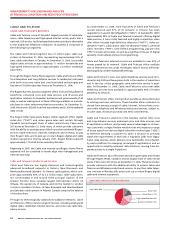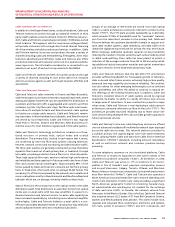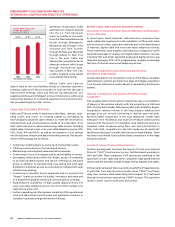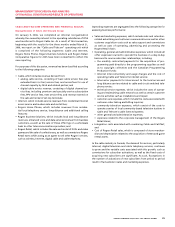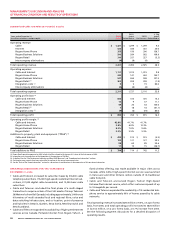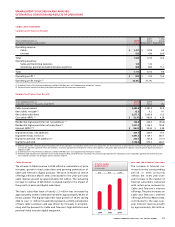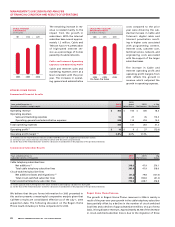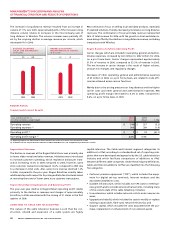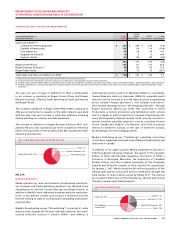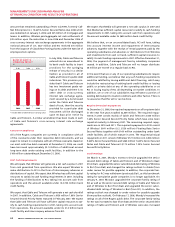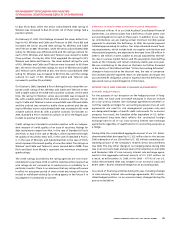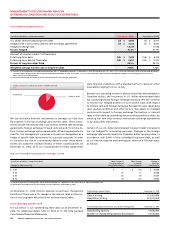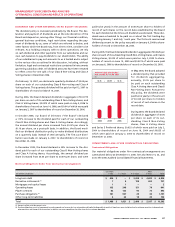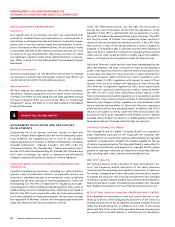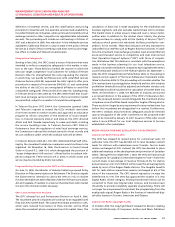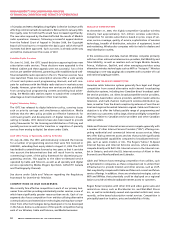Rogers 2006 Annual Report Download - page 46
Download and view the complete annual report
Please find page 46 of the 2006 Rogers annual report below. You can navigate through the pages in the report by either clicking on the pages listed below, or by using the keyword search tool below to find specific information within the annual report.
42 R OG E RS COM MUN I C ATIO NS I NC. 2 0 0 6 AN NUAL R EPO R T
MANAGEMENT’S DISCUSSION AND ANALYSIS
OF FINANCIAL CONDITION AND RESULTS OF OPERATIONS
MEDIA’S STRATEGY
Media seeks to maximize revenues, operating profit and return on
invested capital across each of its businesses. Media’s strategies to
achieve this objective include:
• Focusing on specialized content and audiences through radio,
publication and sports properties, as well as continued develop-
ment of its portfolio of specialty channel investments;
• Continuing to leverage its strong media brand names to increase
advertising and subscription revenues, assisted by the cross-
promotion of its properties across its media formats and in asso-
ciation with the “Rogers” brand;
• Focusing on growth and continuing to cross-sell advertising and
share content across its properties and over its multiple media
platforms; and
• Enhancing the Sports Entertainment fan experience by adding
talented players to improve the Blue Jays win-loss record and by
making physical upgrades to the Rogers Centre.
RECENT MEDIA INDUSTRY TRENDS
Inc reased Fragmentation of Radio and TV
In recent years, Canadian radio and television broadcasters have had
to operate in increasingly fragmented markets. Canadian consumers
have a growing number of radio and television services available to
them, providing them with an increasing number of different pro-
gramming formats. In the radio industry, since the introduction of
its Commercial Radio Policy in 1998, the CRTC has licenced numerous
new radio stations through competitive processes in most markets
across Canada. In that time, the CRTC has also licenced a large
number of additional new FM stations through AM to FM station
conversions. In 2005, the CRTC licenced two satellite radio providers,
both of which are affiliated with U.S. satellite operators and both of
which began offering service in Canada. In the television industry,
the CRTC has licenced a number of new, over-the-air stations and
a significant number of new digital television services. The new
services and the new formats combine to fragment the market for
existing radio and television operators.
Ownership of Canadian radio and TV stations appears to be
consolidating if proposals by CTVglobemedia, Canwest Global
Communications Corp., and Astral Media Inc. to buy CHUM Limited,
Alliance Atlantis Communications Inc. and Standard Radio Inc.,
respectively, receive government and regulatory approval. If
approved the Canadian industry would be left with fewer owners
but larger competitors in the media marketplace.
MEDIA OPER ATING AND FINANCIAL RESULTS
Media’s revenues primarily consist of:
• Advertising revenues;
• Circulation and subscription revenues;
• Retail product sales; and
• Sales of tickets, receipts of league revenue sharing and concession
sales associated with our sports businesses.
Media’s operating expenses consist of:
• Cost of sales, which is primarily comprised of the cost of retail
product at The Shopping Channel;
• Sales and marketing expenses; and
• Operating, general and administrative expenses, which include
programming costs, production expenses, circulation expenses,
player salaries and other back-office support functions.
SUMMARIZED MEDIA FINANCIAL RESULTS
Effective June, 2006, due to increased ownership, the results of
operations of The Biography Channel Canada and G4TechTV Canada
are consolidated with the results of Media. Effective January 2005,
ownership and management of Rogers’ sports operations were
transferred to Media. As such, beginning in the first quarter of 2005,
the results of operations of the Toronto Blue Jays and Rogers Centre
are reported as part of the Media segment.
Summarized Media Financial Results
Years ended December 31,
(In millions of dollars) 2006 2005 % Chg
Operating revenue $ 1,210 $ 1,097 10.3
Operating expenses 1,059 969 9.3
Operating profit (1) $ 151 $ 128 18.0
Operating profit margin (1) 12.5% 11.7%
Additions to property, plant and equipment (1) $ 48 $ 40 20.0
(1) As defined. See the “Key Performance Indicators and Non-GAAP Measures”.
Media Operating Revenue
Revenue growth for 2006 was $113 million, an increase of 10.3%
over 2005, and reflects growth across all of Media’s divisions. This
increase includes higher advertising revenue in Publishing, Radio,
and OMNI, and at Sportsnet where Toronto Blue Jays games and
World Cup Soccer attracted large audiences. The Shopping Channel
continued to generate strong consumer demand for products.
Sports Entertainment revenue grew through higher baseball ticket
sales. The addition of OMNI BC, the launch of OMNI Manitoba, the
launch of Hello! and Chocolat magazines, and consolidation of The
Biography Channel Canada and G4TechTV Canada as a result of
increased ownership in the second quarter of 2006 also contributed
to the increase in revenue.


